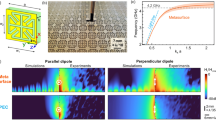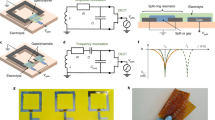Abstract
Transparent metadevices could equip electronic systems with unique functionalities such as anti-interference and stealth capabilities. However, optically transparent devices currently rely on transparent conductive materials, which have low optical transmittance, low operating efficiency and an inability to achieve radiofrequency transparency. Here, we show that metadevices based on quasi-one-dimensional surface plasmon polariton structures can offer optical and radiofrequency transparency. The structures are composed of subwavelength unit cells created from fine metallic lines printed on a flexible and transparent substrate. The approach can be used to create arbitrarily shaped waveguides with topological robustness for transmission applications, and converters for changing surface plasmon polariton waves into space waves for radiation applications. To illustrate the potential of the technology, we use the microwave metadevices to construct a wireless communication scheme for image transfer.
This is a preview of subscription content, access via your institution
Access options
Access Nature and 54 other Nature Portfolio journals
Get Nature+, our best-value online-access subscription
$29.99 / 30 days
cancel any time
Subscribe to this journal
Receive 12 digital issues and online access to articles
$119.00 per year
only $9.92 per issue
Buy this article
- Purchase on Springer Link
- Instant access to full article PDF
Prices may be subject to local taxes which are calculated during checkout






Similar content being viewed by others
Data availability
The data that support the findings of this study are available from the corresponding authors upon reasonable request.
References
Fan, R. H. et al. Transparent metals for ultrabroadband electromagnetic waves. Adv. Mater. 24, 1980–1986 (2012).
Luo, J. et al. Ultratransparent media and transformation optics with shifted spatial dispersions. Phys. Rev. Lett. 117, 223901 (2016).
Palmer, S. J. et al. Extraordinarily transparent compact metallic metamaterials. Nat. Commun. 10, 2118 (2019).
Chu, H. et al. Diffuse reflection and reciprocity-protected transmission via a random-flip metasurface. Sci. Adv. 7, eabj0935 (2021).
Chu, H. et al. Invisible surfaces enabled by the coalescence of anti-reflection and wavefront controllability in ultrathin metasurfaces. Nat. Commun. 12, 4523 (2021).
Zhang, L. et al. Correlated metals as transparent conductors. Nat. Mater. 15, 204–210 (2016).
Li, S. et al. Nanometre-thin indium tin oxide for advanced high-performance electronics. Nat. Mater. 18, 1091–1097 (2019).
Datta, R. S. et al. Flexible two-dimensional indium tin oxide fabricated using a liquid metal printing technique. Nat. Electron. 3, 51–58 (2020).
Sim, K. et al. Three-dimensional curvy electronics created using conformal additive stamp printing. Nat. Electron. 2, 471–479 (2019).
Park, S.-I. et al. Printed assemblies of inorganic light-emitting diodes for deformable and semitransparent displays. Science 325, 977–981 (2009).
Hong, S. et al. Transparent and flexible antenna for wearable glasses applications. IEEE Trans. Antennas Propag. 64, 2797–2804 (2016).
Potti, D. et al. A novel optically transparent UWB antenna for automotive MIMO communications. IEEE Trans. Antennas Propag. 69, 3821–3828 (2021).
Barnes, W. L., Dereux, A. & Ebbesen, T. W. Surface plasmon subwavelength optics. Nature 424, 824–830 (2003).
Fang, N., Lee, H., Sun, C. & Zhang, X. Sub-diffraction-limited optical imaging with a silver superlens. Science 308, 534–537 (2005).
Ozbay, E. Plasmonics: merging photonics and electronics at nanoscale dimensions. Science 311, 189–193 (2006).
Kawata, S., Inouye, Y. & Verma, P. Plasmonics for near-field nano-imaging and superlensing. Nat. Photon. 3, 388–394 (2009).
Gramotnev, D. K. & Bozhevolnyi, S. I. Plasmonics beyond the diffraction limit. Nat. Photon. 4, 83–91 (2010).
Pendry, J. B., Martin-Moreno, L. & Garcia-Vidal, F. J. Mimicking surface plasmons with structured surfaces. Science 305, 847–848 (2004).
García de Abajo, F. J. & Sáenz, J. J. Electromagnetic surface modes in structured perfect-conductor surfaces. Phys. Rev. Lett. 95, 233901 (2005).
Gao, F. et al. Probing topological protection using a designer surface plasmon structure. Nat. Commun. 7, 11619 (2016).
Gong, S. et al. Transformation of surface plasmon polaritons to radiation in graphene in terahertz regime. Appl. Phys. Lett. 106, 223107 (2015).
Zhang, H. C. et al. A plasmonic route for the integrated wireless communication of subdiffraction-limited signals. Light Sci. Appl. 9, 113 (2020).
Xue, T. et al. Ultrasensitive detection of miRNA with an antimonene-based surface plasmon resonance sensor. Nat. Commun. 10, 28 (2019).
Balaur, E. et al. Plasmon-induced enhancement of ptychographic phase microscopy via sub-surface nanoaperture arrays. Nat. Photon. 15, 222–229 (2021).
Ozaki, M., Kato, J.-I. & Kawata, S. Surface-plasmon holography with white-light illumination. Science 332, 218–220 (2011).
Freire-Fernández, F. et al. Magnetic on–off switching of a plasmonic laser. Nat. Photon. 16, 27–32 (2022).
Yu, N. et al. Designer spoof surface plasmon structures collimate terahertz laser beams. Nat. Mater. 9, 730–735 (2010).
Zhang, H. C., Cui, T. J., Zhang, Q., Fan, Y. & Fu, X. Breaking the challenge of signal integrity using time-domain spoof surface plasmon polaritons. ACS Photon. 2, 1333–1340 (2015).
Guan, D. F., You, P., Zhang, Q. F., Xiao, K. & Yong, S. W. Hybrid spoof surface plasmon polariton and substrate integrated waveguide transmission line and its application in filter. IEEE Trans. Microw. Theory Tech. 65, 4925–4932 (2017).
Haffner, C. et al. Low-loss plasmon-assisted electro-optic modulator. Nature 556, 483–486 (2018).
Dong, J. et al. Versatile metal-wire waveguides for broadband terahertz signal processing and multiplexing. Nat. Commun. 13, 741 (2022).
Shen, X., Cui, T. J., Martin-Cano, D. & Garcia-Vidal, F. J. Conformal surface plasmons propagating on ultrathin and flexible films. Proc. Natl Acad. Sci. USA 110, 40–45 (2013).
Chen, L. et al. Mode splitting transmission effect of surface wave excitation through a metal hole array. Light Sci. Appl. 2, e60 (2013).
Fusella, M. A. et al. Plasmonic enhancement of stability and brightness in organic light-emitting devices. Nature 585, 379–382 (2020).
Liu, X. et al. Microcavity electrodynamics of hybrid surface plasmon polariton modes in high-quality multilayer trench gratings. Light Sci. Appl. 7, 14 (2018).
Larkin, I. A. et al. Superanomalous skin effect for surface plasmon polaritons. Phys. Rev. Lett. 119, 176801 (2017).
Maniyara, R. A. et al. Tunable plasmons in ultrathin metal films. Nat. Photon. 13, 328–333 (2019).
Tang, W. X., Zhang, H. C., Ma, H. F., Jiang, W. X. & Cui, T. J. Concept, theory, design, and applications of spoof surface plasmon polaritons at microwave frequencies. Adv. Opt. Mater. 7, 1800421 (2019).
Kang, S. H. & Jung, C. W. Transparent patch antenna using metal mesh. IEEE Trans. Antennas Propag. 66, 2095–2100 (2018).
Acknowledgements
B.W. is grateful for financial support by the National Natural Science Foundation of China (NSFC) under grants 62171348, 62071357 and U19A2055. W.-X.T. is grateful for financial support by the National Natural Science Foundation of China (grant 61971134). T.-J.C. is grateful for financial support by the National Natural Science Foundation of China (grant 62288101). H.-R.Z. and B.W. acknowledge Y. Hao at the Queen Mary University of London for substantial support and assistance on mechanism analysis and representation.
Author information
Authors and Affiliations
Contributions
H.-R.Z. and B.W. conceived the idea and designed the experiment. B.W. and T.-J.C. supervised the project. H.-R.Z., B.C. and W.-H.L. performed the experiments. H.-R.Z. and B.C. analysed the experimental data. H.-R.Z. performed the simulation. H.-R.Z. and B.W. wrote the initial manuscript. B.C. upgraded the illustration presentation. W.-X.T., T.-J.C. and D.-P.H. revised and improved the manuscript. All the authors discussed the results and commented on the manuscript.
Corresponding authors
Ethics declarations
Competing interests
The authors declare no competing interests.
Peer review
Peer review information
Nature Electronics thanks Yun Lai and the other, anonymous, reviewer(s) for their contribution to the peer review of this work.
Additional information
Publisher’s note Springer Nature remains neutral with regard to jurisdictional claims in published maps and institutional affiliations.
Supplementary information
Supplementary Information
Supplementary Notes 1–10.
Supplementary Video 1
Optical transparency and flexibility of the proposed quasi-1D-structured SPP samples.
Supplementary Video 2
Mode distribution measurement of the proposed quasi-1D-structured SPP sample.
Supplementary Video 3
Radiofrequency transmittance measurement of the proposed quasi-1D-structured SPP sample.
Rights and permissions
Springer Nature or its licensor (e.g. a society or other partner) holds exclusive rights to this article under a publishing agreement with the author(s) or other rightsholder(s); author self-archiving of the accepted manuscript version of this article is solely governed by the terms of such publishing agreement and applicable law.
About this article
Cite this article
Zu, HR., Wu, B., Chen, B. et al. Optically and radiofrequency-transparent metadevices based on quasi-one-dimensional surface plasmon polariton structures. Nat Electron 6, 525–533 (2023). https://doi.org/10.1038/s41928-023-00995-z
Received:
Accepted:
Published:
Issue Date:
DOI: https://doi.org/10.1038/s41928-023-00995-z



